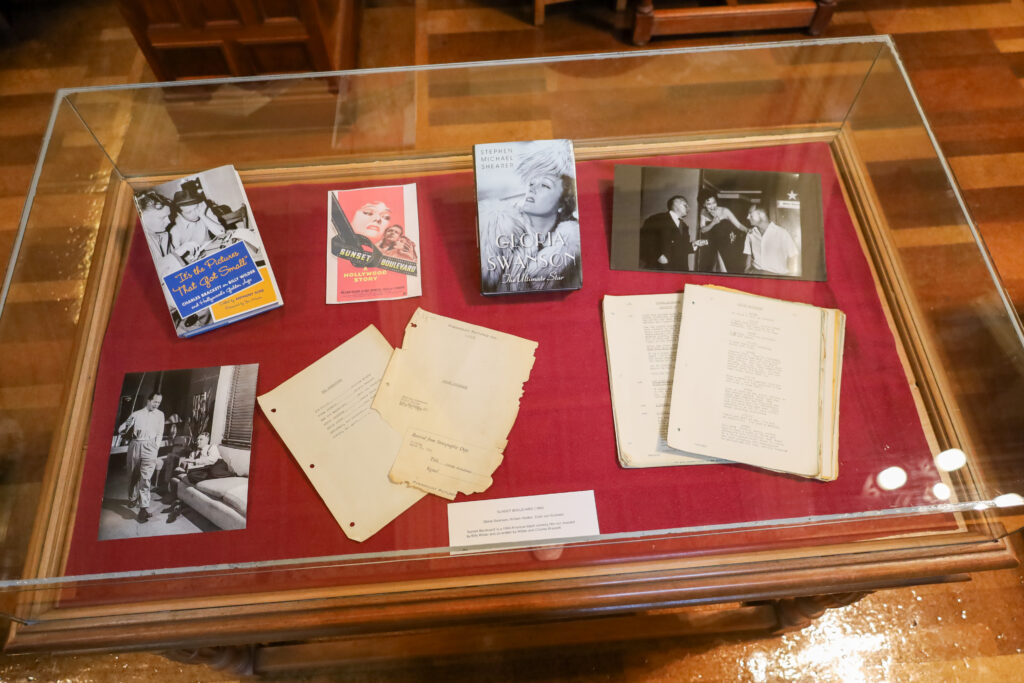Ainsley Harris ’26
Staff Writer
Denison Library’s newest exhibit “Scripts at Scripps” by Lydia Ringwald ’70 opened this summer, featuring scripts, costume designs, caricatures, and other memorabilia from Hollywood’s Golden Age, centering women in film and the contributions of 1940s actor John Lund. Ringwald sourced this exhibit from her personal collection and was motivated by her fascination with noir films and the Golden Age of Hollywood.
“I was born in LA, if you’re born in LA, a lot of it is Hollywood,” Ringwald said. “Beverly Hills and West Hollywood is part of the culture of LA, it was always there in my life, you know. So I was always connected to Hollywood and I was always fascinated with the movies.”
Back when Ringwald was attending Scripps College, this era of Hollywood served as inspiration for her writing. She wrote several scripts as an undergraduate and continued writing into the 1980s. Though she never found a career as a screenwriter – instead pursuing careers including professor, realtor, renovator, and art collector – she wanted to use this exhibit to continue to inspire future generations.
“These are historical documents,” Ringwald said. “There is inspiration for people that want to write, you know, that they can access these films and figure out how it could be restructured. I just put it there as inspiration, that’s why I’m speaking about it.”
Ringwald began collecting Golden Age Hollywood memorabilia in the late 1980s, sparked by her unlikely relationship with popular Golden Age actor Lund. In the ’80s Ringwald lived on Coldwater Canyon Drive in Beverly Hills, and was completely unaware that her neighbor was the leading man in her favorite movie A Foreign Affair.
“There was a big rainstorm; some of his eucalyptus trees’ branches fell onto my property, so I used that as an excuse to go and knock on his door — a beautiful older man came out,” Ringwald told me. “I didn’t know who he was. You see, I’m kind of somewhat psychic so I just kept going over. He was so good-looking I knew he had to be an actor.”
Ringwald’s psychic intuitions proved correct. Beyond just the leading man in A Foreign Affair, Lund also starred in To Each His Own, No Man of Her Own, The Mating Season, and more. He acted alongside some of the most famous women of that era: Marlene Dietrich, Barbara Stanwyck, Olivia de Havilland, Lana Turner, and Gene Tierney. His naturally blonde hair, dyed black in his various roles, had stopped Ringwald from recognizing him.
From their first meeting, a close relationship bloomed.
“We had some good times together, you know, go out to dinner together” Ringwald said.“When I was in a conversation with him, I felt like a movie star. I mean, he was a lot older than I was, you know, I have to say, what can I do if – we were good friends. Let’s put it that way.”
Ringwald only knew Lund for a few years before he passed, but in that time he shared with her insights into the industry and stars he had worked with.
“He said [Dietrich] did the lighting,” Ringwald said. “She would come early in the morning with the lighting technicians and set up all the lights. You think she’s just a glamor. But she was a hard worker. She was meticulous too – her costume and dress down to the last detail. Obsessed with it. And he would say that she’d always hold a mirror up before they did a scene to look at herself so she’d be prepared.”
Lund also provided Ringwald with her collection of scripts now on display. He gifted his collection of scripts to Ringwald just before he passed. The scripts in the exhibit showcase movies he starred in – featuring his notes in the margins – as well as early versions of scripts he was sent when studios were considering him for a role.
“His handwritten notes show you how he was thinking through his character and how to present his character – what little nuances he could make, those little hand gestures or facial expressions that would tell the story,” Ringwald said.
Besides Lund, Ringwald’s exhibit at Denison also features a few prominent producers, writers, and directors from the Golden Age of Hollywood. Billy Wilder and Charles Bracket are both featured in the exhibit and worked closely with Lund. One of the display cabinets is devoted to Catherine Turney, a screenwriter for Warner Brothers in the 1940s.
“Catherine Turney deserves a lot more credit,” Ringwald said. “She was the first woman on contract. You see those big studios in the ’40s, ’30s, they would put writers on contract, you know, to churn out all the scripts, and she was the first woman to be on contract.”
Part of Ringwald’s goal for this exhibit was to bring attention to Turney. Turney wrote explosively successful scripts with strong female main characters for leading actresses like Betty Davis, Joan Crawford, and Barbara Stanwyck.
“The woman character was your main character,” Ringwald said. “There were strong women characters, and the men were actually a little bit more supporting characters. In those days, it was very empowering for women to see those characters on the screen.”
Featured in Turney’s case is an original script of No Man of Her Own – in this edition called I Married a Dead Man – in which Lund and Barbara Stanwyck starred together. The script came from Lund’s personal collection and it (along with other Turney scripts he passed onto Ringwald) sparked Ringwald’s admiration for Turney.
Beyond the scripts Lund passed onto Ringwald, the exhibit contains a visual element featuring several movie and set stills related to scripts. The most visually striking element of Ringwald’s exhibit is the costume design and caricatures. The exhibit features a stunning original costume design in gouache for Natalie Wood by Edith Head, an eight-time Academy Award winner. Alongside the costume design are caricatures by Al Hirschfeld, who was famous for his caricatures of Golden Age stars – Judy Garland, Frank Sinatra, Dean Martin, Elizabeth Taylor, and Richard Burton. This exhibit includes his caricatures of Dietrich and Josephine Baker.
Ringwald’s exhibit “Scripts at Scripps” is on display at Denison, which is open weekdays, until mid-October. She invites the Scripps community to interact with the stories of the influential women in film highlighted in the collection.
Photo Courtesy: Frances Walton ’26





